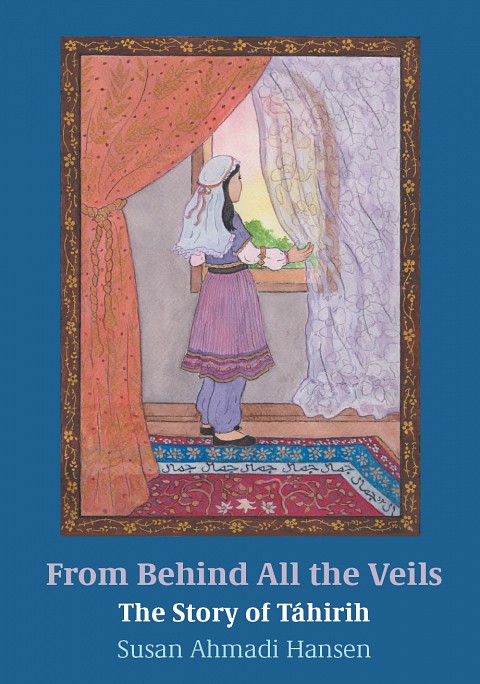The State of the Art:
Books for Bahá’í Children, 2019
by ALLISON GROVER KHOURY


A survey of the few Bahá’í children’s books that were published this past year in English brings to light some suitable options for parents and their children. A number of picture books were published in honor of the Bicentenary of the Birthday of the Báb celebrated this past year in 2019. Will Van den Hoonard’s excellent The Story of the Báb, which appeared in the Did You Ever Wonder... series, is one of these; it was reviewed in issue # 7 of e*lix*ir. Of the other children’s books released in honor of the Bicentenary, my favorite is The Moon Was There: Glimpses from the Báb’s Childhood for Young Children, written and published by Alhan Rahimi and illustrated by Anahit Alexsanyan. Intended for ages 2-6, this endearing book is narrated by the friendly crescent moon, which does precisely what the book’s title suggests it will do: give readers glimpses of the Báb’s childhood. The book closes with the moon giving readers a photo tour of the Báb’s home in Shiraz, Iran and showing them some items that a child would find interesting: for example, the Báb’s prayer beads and an example of calligraphy He did as a child of ten. In my view, The Moon Was There sets just the right tone, of excitement and also reverence, for a special Being who holds a special station in this dispensation.

Alhan Rahimi published another book in 2019, Mulla Husayn: The Story of the Declaration of the Báb for Young Children, which traces Mulla Husayn’s quest to find The Promised One and is enlivened by illustrations by Alina Onipchenko. This book fills a gap in books about the life of The Báb intended for early readers. Emphasizing Mulla Husayn’s spiritual insight as well as his scholarship and devotion, it shows that his journey to find the Promised One was guided by prayer and his well developed spiritual faculties. Alhan Rahimi’s books are available on Amazon.com and from her website persianarabic.com.

A picture book of note about another of the Báb’s early disciples is entitled From Behind All the Veils: The Story of Tahirih written by Susan Ahmadi Hansen and illustrated by Susan Reed. Tahirih is an extraordinary figure in all of history as well as in Bahá’í history. A brilliant intellect,a champion of women’s rights, a skilled poet, and a deeply spiritual presence in the Bábí movement, Tahirih was one of the first to recognize and follow the Báb. This rich theme is ably explored in this 30-page long picture book. Written for ages 7-8, this book, nevertheless, includes some sophisticated concepts. Still, it tells its story in a way that can be followed by young children. Some important details about Tahirih’s life were left out, to the story’s detriment; while other details were included that might have been left out. I also wished there were more of Susan Reed’s lovely Persian drawings; they really brought the words to life by giving use a glimpse into the world of Persia 150 years ago. All considered, this book is a worthy addition to the library of every Bahá’í because of its value in teaching children about this important figure.

On an entirely different subject, with respect to resources and children’s books for help in coping with the emotional and spiritual challenges facing us all during a global pandemic, I want to recommend some resources from a remarkable Bahá’í author from Eastern Canada. Over the last year or so I have been following the work of a writer/illustrator Elaheh Bos. I first came across her children’s book Mason’s Greatest Gems (2015) while looking for picture books on nurturing virtues in very young children. Her website Plant Love Grow includes a range of very helpful books and resources for parents, families, teachers, and therapy professionals, devoted to supporting children through challenging life experiences. Ms. Bos has written and illustrated books on facing uncertainty, fears, and anxiety; dealing with anger issues; having trouble falling asleep; coping with death and grief, as well as the challenges presented by selective mutism, sound sensitivity, ADHD, and much more. Her website is rich with journals, coloring pages, support materials, as well as brightly colored books.

A brightly colored, engaging book about facing the loss of a loved one, The Lovebird’s Freedom, written by Esther Maloney and illustrated by Ms. Bos, gently explores the meaning of life and death by means of the metaphor of a caged bird. The book is longer than most picture books, but thorough in exploring the feelings of Lydia, the young protagonist, who is coping with the death of a beloved aunt. With the support of a kind friend who cares for injured birds until they are well enough to be released back into the wild, Lydia comes to see that the bird she looks after is truly able to express itself, live joyfully, and realize its full potential once it is released from its cage. This realization is a great source of comfort and healing for Lydia as she comes to terms with her aunt’s recent passing. While I would have preferred that the book had more pages and less text per page, the story was engaging enough that my daughter could follow it. There are also additional resources and art projects in the back matter. Ms. Bos has also created beautiful Bahá’í prayer books, art projects, and other delightful materials for children that are available on Amazon and from her other website.

In time for Ridvan this year, Alhan Rahimi released a lovely new book entitled Garden of Ridvan: The Story of the Festival of Ridvan for Young Children. The books tells the story of Bahá’u’lláh’s arrival, stay and declaration in the Najibiyyih Garden in Baghdad, as narrated by a nightingale who lives in the garden of Ridvan and longs for the world to know of its beauty. Excited by the coming of a special guest, the nightingale begins to sing even more loudly and joyfully than usual. Ms. Rahimi’s telling is spare but still captures the beauty and emotion of such a significant event in Bahá’í history. Illustrations by Alina Onipchenko, who also illustrated Ms. Rahimi’s book about the Mullá Husayn, grace the pages. Onipchenko’s gift for painting roses and garden scenes produce gorgeous results, and bring the garden to life for all of us who have never had the privilege of seeing it. In a moving effort, no doubt, to counter the darkness of the past few months, Ms. Rahimi dedicates this story of light and love and hope to “the peoples of the world enduring the global pandemic of 2020.”

